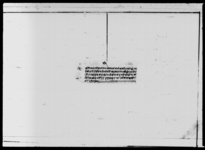A purjī from Garuḍadhvaja Pā̃ḍe ordering the provision of additional wheat to Prasāda Siṃ (VS 1878)
ID: E_2778_0002
Edited and
translated by Surabhi Pudasaini
in collaboration with
Pabitra Bajracharya
Created: 2022-07-18;
Last modified: 2022-12-31
For the metadata of the document, click here
The accompanying edition, translation/synopsis and/or commentary are available under the terms of the Creative Commons Attribution-ShareAlike 4.0 International License
Abstract
This purjī from the kapardāra Garuḍadhvaja Pā̃ḍe orders the aḍais Rājabala Ḍoṭyāla and Ramānātha Pādhyā to provide additional wheat to one Prasāda Siṃ.Diplomatic edition
[1r]
1⟪२⟫1⟪४⟫1श्री\1अडैराजवलडोट्यालरमानाथपाध्याकेश्रीकपर्दारगरुडध्वजपा2डेकोपुर्जिऊप्रांतदर्वारकोपटिमाजगतनैनाकोछोराप्रसाद
3सिंलाएकछाकताहाफर्दामालेषीय़ाकोछगहुंपाथी१५थ
4पिदिय़ाकोछभरिदेऊइतिसम्वत१८७८सालआषाढ
5वदि१रोजशुभ्म्¯¯¯ ¯¯¯ ¯¯¯ ¯¯¯ ¯¯¯ ¯¯¯ ¯¯¯ ¯¯¯
Translation
[1r]
2
4
1To Aḍais Rājabala Ḍoṭyāla [and] Ramānātha Pādhyā
A purjī from Śrī KaparadāraGaruḍadhvaja Pāḍe
Uprānta: For Prasāda Siṃ, the son of the Jagatanainā who serves the darabāra (darabārako paṭimā jagatanainā),2 one meal is written in the pharda there. 15 pāthīs of wheat has been added. Disburse [that amount] (bhari deū).
[...day], the first of the dark fortnight of Āṣāḍha, in the [Vikrama] era 1878 (1821 CE). May it be auspicious.
Commentary
This is a note from the kaparadāra Garuḍadhvaja Pā̃ḍe ordering two aḍais to provide wheat to Prasāda Siṃ, a son of Jagatanainā, who was a servant in the palace. This note indicates that the kaparadāra’s office kept a list (pharda) of servants who were to receive grains. This list specified whether the person was to receive grains for one or two daily meals. For instance, while Prasāda Siṃ had originally been entitled to one meal, Rājavīra is recorded as having been granted two meals in a similar document (E_2778_0006). In this note, the kaparadāra adds to the listed amount.
This is one of ten documents (E_2778_0001 to E_2778_0010) recording the distribution of wheat to various people who worked within the Hanumānḍhokā palace complex. All the orders date to VS 1878 (1821 CE). Many of them relate to the wheat crop from the Lubhuserā land in that year. This note differs from the rest in lacking the formulaic line confirming that the deductions in the accounts corresponding to this addition would take place when the ledgers were submitted for control (bahī bujhdā mojarā parlā)
Savāla 3 of RRC_0024_0776, laying out Bhoṭu Pā̃ḍe’s duties as kaparadāra in VS 1859, confirms that the kaparadāra was responsible for ascertaining the amount of foodgrains that palace servants received. Garuḍadhvaja Pā̃ḍe appears to be fulfilling that duty here. The ten directives were issued over the course of three months from Jeṭh to Bhadau. Ascertaining the amount of foodgrains that individual palace servants received was, therefore, not a task concluded in parallel. Rather, the amounts were reviewed and confirmed serially.
Garuḍadhvaja was kaparadāra from the early VS 1870s till the early 1890s. He was a son of the former kaparadāra Bhoṭu Pā̃ḍe (see Pā̃de Chetrī 1977: 246). Though the authority to ascertain amounts rested with the kaparadāra, the orders were carried out by two aḍais, Rājabala Ḍoṭyāla and Ramānātha Pādhyā. Aḍais were employed at the Koṭa Bhaṇḍāra, which managed the stores of foodstuffs within the royal palace complex. Each serā was also put under the management of one or a pair of aḍais.3 Outside the current ten documents, Rājabala Ḍoṭyāla appears again in relation to Lubhu serā [land] in VS 1880 in E_2764_0046.

